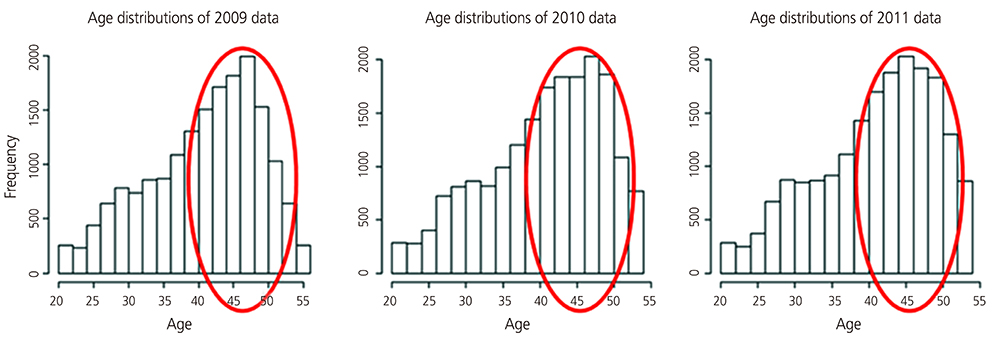Obstet Gynecol Sci.
2017 Nov;60(6):579-586. 10.5468/ogs.2017.60.6.579.
Comorbidity of gynecological and non-gynecological diseases with adenomyosis and endometriosis
- Affiliations
-
- 1Department of Obstetrics and Gynecology, College of Medicine, Ewha Womans University, Seoul, Korea. sarahmd@ewha.ac.kr
- 2Division of Biomedical Informatics, Center for Genome Science, National Institute of Health, Korea Centers for Disease Control and Prevention (KCDC), Cheongju, Korea.
- KMID: 2418360
- DOI: http://doi.org/10.5468/ogs.2017.60.6.579
Abstract
OBJECTIVE
Adenomyosis and endometriosis are relatively common gynecological diseases that exhibit many common features. This study identified gynecological and non-gynecological diseases that exhibited comorbidity with adenomyosis and endometriosis in Korean women.
METHODS
We used Health Insurance Review and Assessment data from 2009 to 2011 and searched for adenomyosis and endometriosis (coded as N80.1 and D25 in International Classification of Disease, 10th revision [ICD-10], respectively). We selected records from patients who had independent disease occurrences in each year, and comorbidities were estimated using Fisher's exact test. We computed each year's similarities and combined 3 years' results using Fisher's P-value summation method.
RESULTS
A total of 61,516 patients' data were collected during the study period. The prevalence of adenomyosis and endometriosis were similar each year: 12.4% and 9.3% in 2009, 12.5% and 9.4% in 2010 and 13.3% and 9.1% in 2011, respectively. Meta-analysis revealed that 31 ICD-10 codes were significantly related with adenomyosis, and 44 ICD-10 codes were related with endometriosis. Gynecological diseases, such as leiomyoma and benign ovarian tumor, were significantly related to adenomyosis and endometriosis. Non-gynecological diseases, such as anemia and hypercholesterolemia, were also related to adenomyosis and endometriosis.
CONCLUSION
We must monitor for the presence of gynecological and non-gynecological diseases with co-morbidities during evaluations and follow-up of patients with adenomyosis or endometriosis.
Keyword
MeSH Terms
Figure
Cited by 1 articles
-
Comprehensive Analysis of Iron Deficiency Anemia and Its Related Disorders in Premenopausal Women Based on a Propensity Score Matching Case Control Study Using National Health Insurance Service Database in Korea
Hyun Jung Lee, Haeyong Pak, Jae Joon Han, Myung Hee Chang
J Korean Med Sci. 2023;38(37):e299. doi: 10.3346/jkms.2023.38.e299.
Reference
-
1. Rapkin AJ, Nathan L. Pelvic pain and dysmenorrhea. In : Berek JS, Novak E, editors. Berek & Novak's gynecology. 15th ed. Philadelphia (PA): Lippincott Williams & Wilkins;2012. p. 470–504.2. Garcia L, Isaacson K. Adenomyosis: review of the literature. J Minim Invasive Gynecol. 2011; 18:428–437.3. Hemmings R, Rivard M, Olive DL, Poliquin-Fleury J, Gagné D, Hugo P, et al. Evaluation of risk factors associated with endometriosis. Fertil Steril. 2004; 81:1513–1521.4. Renner SP, Strick R, Fasching PA, Oeser S, Oppelt P, Mueller A, et al. Single nucleotide polymorphisms in the progesterone receptor gene and association with uterine leiomyoma tumor characteristics and disease risk. Am J Obstet Gynecol. 2008; 199:648.e1–648.e9.5. Leyendecker G, Bilgicyildirim A, Inacker M, Stalf T, Huppert P, Mall G, et al. Adenomyosis and endometriosis. Re-visiting their association and further insights into the mechanisms of auto-traumatisation. An MRI study. Arch Gynecol Obstet. 2015; 291:917–932.6. van den Akker M, Buntinx F, Metsemakers JF, Roos S, Knottnerus JA. Multimorbidity in general practice: prevalence, incidence, and determinants of co-occurring chronic and recurrent diseases. J Clin Epidemiol. 1998; 51:367–375.7. Feinstein AR. The pre-therapeutic classification of co-morbidity in chronic disease. J Chronic Dis. 1970; 23:455–468.8. Charlson ME, Pompei P, Ales KL, MacKenzie CR. A new method of classifying prognostic comorbidity in longitudinal studies: development and validation. J Chronic Dis. 1987; 40:373–383.9. Long AN, Dagogo-Jack S. Comorbidities of diabetes and hypertension: mechanisms and approach to target organ protection. J Clin Hypertens (Greenwich). 2011; 13:244–251.10. Vercellini P, Viganò P, Somigliana E, Daguati R, Abbiati A, Fedele L. Adenomyosis: epidemiological factors. Best Pract Res Clin Obstet Gynaecol. 2006; 20:465–477.11. Taran FA, Stewart EA, Brucker S. Adenomyosis: epidemiology, risk factors, clinical phenotype and surgical and interventional alternatives to hysterectomy. Geburtshilfe Frauenheilkd. 2013; 73:924–931.12. Matalliotakis IM, Cakmak H, Fragouli YG, Goumenou AG, Mahutte NG, Arici A. Epidemiological characteristics in women with and without endometriosis in the Yale series. Arch Gynecol Obstet. 2008; 277:389–393.13. McLeod BS, Retzloff MG. Epidemiology of endometriosis: an assessment of risk factors. Clin Obstet Gynecol. 2010; 53:389–396.14. R Development Core Team (AT). R: a language and environment for statistical computing. Vienna: R Foundation for Statistical Computing;2011.15. Nezhat C, Li A, Abed S, Balassiano E, Soliemannjad R, Nezhat A, et al. Strong association between endometriosis and symptomatic leiomyomas. JSLS. 2016; 20:e2016.16. Kvaskoff M, Han J, Qureshi AA, Missmer SA. Pigmentary traits, family history of melanoma and the risk of endometriosis: a cohort study of US women. Int J Epidemiol. 2014; 43:255–263.17. Teng SW, Horng HC, Ho CH, Yen MS, Chao HT, Wang PH, et al. Women with endometriosis have higher comorbidities: analysis of domestic data in Taiwan. J Chin Med Assoc. 2016; 79:577–582.18. Fuldeore M, Yang H, Du EX, Soliman AM, Wu EQ, Winkel C. Healthcare utilization and costs in women diagnosed with endometriosis before and after diagnosis: a longitudinal analysis of claims databases. Fertil Steril. 2015; 103:163–171.19. Uimari O, Järvelä I, Ryynänen M. Do symptomatic endometriosis and uterine fibroids appear together? J Hum Reprod Sci. 2011; 4:34–38.20. Melo AS, Rosa-e-Silva JC, Rosa-e-Silva AC, Poli-Neto OB, Ferriani RA, Vieira CS. Unfavorable lipid profile in women with endometriosis. Fertil Steril. 2010; 93:2433–2436.21. Kvaskoff M, Mu F, Terry KL, Harris HR, Poole EM, Farland L, et al. Endometriosis: a high-risk population for major chronic diseases? Hum Reprod Update. 2015; 21:500–516.
- Full Text Links
- Actions
-
Cited
- CITED
-
- Close
- Share
- Similar articles
-
- Descriptive Study on Sexuality for Women with Gynecological Cancer
- Endometriosis of the Appendix
- Recurrent Cerebral Infarction Associated with Uterine Adenomyosis
- A case of inguinal endometriosis in the absence of previous gynecologic surgery
- Clinical applications of levonorgestrel-releasing intrauterine system to gynecologic diseases


